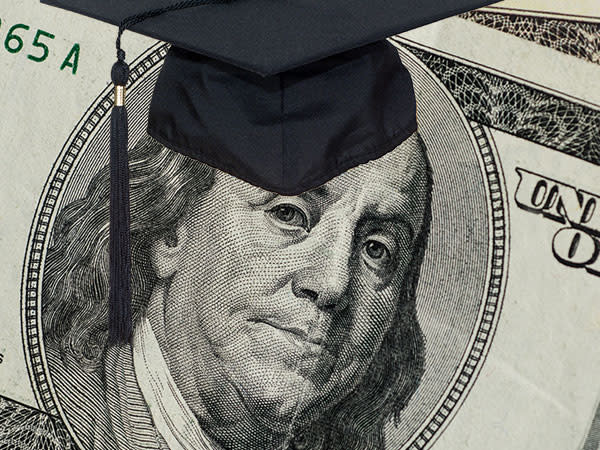How to Pay Back Student Loans—and Still Have a Life

(Photo: 9george/Shutterstock)
By Allison Stadd
Let’s start with the numbers.
According to Time, the class of 2016 graduated with the highest-ever amount of debt, at an average $37,172 per borrower. That’s helped lead to a nationwide total of $1.19 trillion in student debt.
And it doesn’t stop at undergrad. The master’s degree is the fastest-growing college credential in the US. As Forbes reported, while only 14 percent of higher education students are earning graduate degrees, their loans account for a whopping 40 percent of total student debt.
The cost of education has become an unwieldy burden for a massive portion of Americans. If you’re one of the 70 percent of students who graduated recently with loans, you know how stressful it is to carry that weight as you plan for your future, let alone in your daily life. It can be difficult to justify paying for expenses like going out to eat with friends, a magazine subscription or a birthday gift for your sister when those funds could go to paying off your loans. It can feel like you’ll collapse under the load of debt you owe before you’ll ever pay it all off.
But there’s hope.
Smart strategies abound for paying back your student loans while still having a life. You can be financially responsible without sacrificing socializing with friends or spending money on your hobbies.
Below are real-life tips, tricks and advice from graduates who have been there.
Do your research. As business technology analyst Ryan Griffith, who earned his undergrad degree from Rutgers, put it: “Learn about your student loans. This may sound rudimentary, but it is important to determine which loans to target first and how much you want to pay down.”
Two popular debt repayment methods are the “snowball method” and “avalanche method.” The former has you pay off the loans with the smallest balance first; with the latter you start with the loan that has the highest interest rate. Check out unbury.me to calculate which path might be better for you.
Another option for federal student loans is an income-driven repayment plan, which resets your monthly payment based on your current income and family size. Typically, the amount is around 10-15 percent of your discretionary income; if you aren’t bringing in much each paycheck, that amount could be as low as $0.
Put bonus funds toward your loans. Cathie Urushibata, a graphic designer who earned her Master of Professional Studies degree in Art Therapy, pays a little extra toward her loans whenever possible in order to get rid of the debt quicker. “When I make extra money—say, through a freelance job, bonus or a good tax return—I’ll put that money towards my loan,” she said.
Think of your loan payment as a utility bill. Urushibata budgets the minimum amount she owes toward her grad school loans each month so she doesn’t even consider that money part of her monthly disposable income. Similarly, Jacob Berman, a data analyst who earned his Master’s in Public Administration, views his recurring loan payment as a utility.
He said, “I just add it onto rent and cable as untouchable money each month.”
Likewise, law school grad Jeremy Siegel takes care of his loan payment before anything else. “My perspective is that my loan obligations are priority number one,” he said. “The first thing I pay every month is my loans.”
When you don’t even think of that money as spendable, you won’t feel any hit to your day-to-day financial routine.
Spend strategically. Student loans inevitably come with an opportunity cost. Depending on how much money you earn, you likely have to make some tough choices on what you buy or invest in outside of your loan payments. For Berman, that means prioritizing his passion—competitive ballroom dancing—and day-to-day social life: “I choose to spend my money on dance and the occasional fun thing in the city rather than big splashy purchases or huge trips.”
Another approach is to spend moderately on all the pursuits you enjoy. Editor Amanda Chan, when paying off her student loans from grad school in journalism, still went out to eat, shopped and took vacations, but did so thoughtfully. “I made sure to live within my means, while still having fun,” she said. “I love food, so I made sure to limit my restaurant-going to weekends, and brought my lunch to work to avoid spending $12 on salad. I loved to go out on weekends with my friends, but I made a point to not spend money on cabs and instead took the subway. I went on vacation, but did so on a budget; for example, my then-roommate and I planned a trip to Miami, but went in February when air tickets were cheaper, and we stayed in a hostel while there.”
Strategic spending also means budgeting diligently so you know where your money is going and can account for discretionary purchases. Take it from Sarah J. Liao, who recently paid off her Master of Public Health degree and works as a Product Safety & Regulatory Specialist: “I kept track of all of my expenses by category, but I never felt the need to limit my ‘fun’ because of my student debt. I still went out, bought clothes and traveled a ton, all while never feeling like I was struggling with my finances.” With proactive planning comes a sense of financial freedom.
Paying off debt is never an easy venture. But there’s no right or wrong approach to balancing your financial obligations with still having a life. Whatever works best for you, keep your eye on the long-term prize: a debt-free life.
As Urushibata put it, “Once I do pay my loans off completely, it will feel like I got a raise!”

